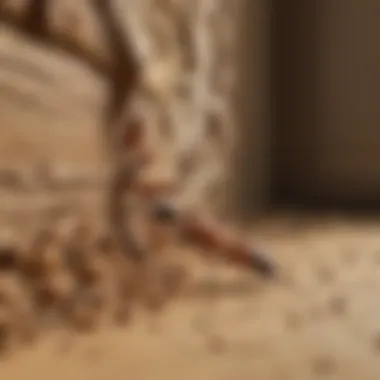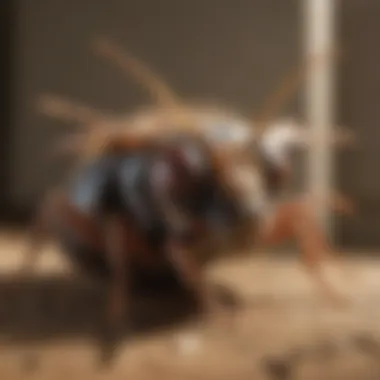Unveiling the Profound Impact of Regular Pest Control Practices on Termite Infestations


Preventive Pest Control Strategies
When it comes to effectively managing termite infestations, preventive pest control strategies play a pivotal role in maintaining a pest-free environment at home. Starting with house exterior protection, sealing cracks and crevices with high-quality caulk is essential to prevent termite entry points. Clearing debris around the house eliminates potential termite habitats, reducing the risk of infestations. Additionally, implementing measures to prevent pests from entering the home, such as installing screens on doors and windows, acts as a barrier against unwanted intruders.
In terms of yard maintenance, engaging in essential routines like regular mowing, pruning, and removing standing water helps in creating an unwelcoming environment for termites and other pests. Methods such as mulching with pest-repellent materials and proper drainage systems aid in keeping the yard free from conducive conditions for pests to thrive.
Indoor cleanliness is paramount in pest prevention. Expert cleaning tips and techniques include regularly vacuuming and dusting, sealing food containers tightly, and promptly fixing any leaks or moisture issues. Maintaining a pest-resistant indoor environment involves thorough sanitation practices and minimizing clutter where pests can hide.
Proper garbage disposal is crucial as it eliminates food sources for pests. Implementing efficient waste disposal methods such as using sealable trash cans, disposing of trash regularly, and paying attention to composting practices can significantly reduce the risk of attracting termites and other pests. Emphasizing the importance of proper garbage disposal to all household members is key to fostering a pest-aware environment.
Innovative pest prevention strategies go beyond traditional methods and may include introducing natural deterrents like planting pest-repelling plants around the house, using ultrasonic pest repellers, or utilizing electronic pest control devices. These innovative approaches bolster the overall pest management efforts and contribute to long-term termite infestation prevention.
Introduction
Regular pest control plays a crucial role in averting termite infestations, safeguarding properties, and ensuring the well-being of individuals. This section serves as the foundation for understanding the significance of implementing consistent pest management practices to combat termite issues. By delving into the intricacies of pest control methods, this article aims to illuminate the transformative impact that proactive pest control measures can have on eradicating termite populations.
Understanding Termite Infestations
Characteristics of Termites
Termites are known for their destructive nature, feeding on cellulose materials within structures and causing extensive damage over time. Their ability to remain hidden within walls and wooden structures makes them particularly challenging to detect without professional intervention. Understanding the behavioral patterns and nesting habits of termites is essential in devising effective pest control strategies. By examining the unique characteristics of termites, such as their caste system and foraging behavior, individuals can better identify and address termite infestations promptly, mitigating potential structural threats.
Signs of Termite Infestations
Recognizing the signs of termite infestations early is imperative in preventing widespread damage to properties. Common indicators include discarded wings, mud tunnels along walls, and hollow-sounding wood. Identifying these red flags enables homeowners to take swift action and engage pest control services to address termite colonies before significant harm ensues. By being attuned to the signs of termite presence, individuals can proactively protect their homes from structural compromise and costly repairs.
Importance of Pest Control
Preventing Structural Damage
Effective pest control measures serve as a barrier against structural deterioration caused by termite activity. By implementing regular inspections and treatments, homeowners can fortify their properties against termite infestations and preserve the integrity of wooden structures. Preventing structural damage through pest control not only sustains the longevity of buildings but also minimizes the financial burden associated with termite-related repairs.
Protecting Health
In addition to safeguarding properties, pest control plays a critical role in protecting the health of individuals residing in infested areas. Termites can contribute to respiratory issues and allergic reactions, posing a threat to occupants' well-being. By prioritizing pest control practices, homeowners can create healthier living environments free from the harmful effects of termite infestations. Maintaining a pest-free home promotes overall well-being and ensures a safe and comfortable living space for residents.
Types of Pest Control
Chemical Treatments


Liquid Termiticides
Liquid termiticides represent a fundamental aspect of pest control strategies, known for their effectiveness in targeting termite infestations at the source. The key characteristic of liquid termiticides lies in their ability to create a protective barrier around structures, preventing termites from infiltrating and causing damage. Their wide popularity stems from the immediate impact they have on termite populations, significantly reducing their numbers and curbing potential structural harm. Liquid termiticides offer the advantage of long-lasting protection, providing continuous defense against termites. However, it's essential to consider the potential disadvantages such as environmental impact and the need for careful application to maximize effectiveness.
Termite Baits
Termite baits introduce a proactive approach to pest control by luring termites away from structures and eliminating them systematically. The primary characteristic of termite baits is their ability to disrupt termite foraging patterns, leading the insects to consume the bait and subsequently share it within their colony, targeting the entire population. This method is a beneficial choice for an integrated pest management approach, as it focuses on eradicating termites while minimizing environmental impact. The unique feature of termite baits lies in their ability to provide targeted treatment, reducing the need for extensive chemical application throughout the property. While termite baits offer advantages in precision and eco-friendliness, careful monitoring and maintenance are essential to ensure their continued efficacy in termite control.
Physical Barriers
Metal Screens
Metal screens act as physical barriers that prevent termites from gaining access to buildings through small cracks and openings. The critical characteristic of metal screens is their durability and resilience, offering long-term protection against termite intrusion. Metal screens are a popular choice for their effectiveness in blocking termites' entry points, securing structures from potential infestation. The unique feature of metal screens is their ability to provide a non-toxic and environmentally friendly solution to termite control. While metal screens offer advantages in durability and sustainability, proper installation and maintenance are necessary to ensure their continuous effectiveness.
Treated Wood
Treated wood serves as an essential component in pest control, incorporating insect-repellent chemicals into the wood to deter termite attacks. The key characteristic of treated wood is its ability to withstand termite infestations due to the added protective compounds. Treated wood is a beneficial choice for pre-construction applications, providing preemptive termite defense for new structures. The unique feature of treated wood lies in its proactive approach to termite prevention, offering long-lasting protection against wood-damaging insects. While treated wood offers advantages in termite resistance and longevity, periodic inspections and treatments are necessary to maintain its efficacy in protecting against termite infestations.
Effectiveness of Regular Pest Control
Regular pest control plays a vital role in managing and eradicating termite infestations effectively. It serves as the cornerstone of maintaining a pest-free environment and safeguarding properties from structural damage and potential health risks. By implementing a consistent pest control regimen, homeowners can proactively combat termite infestations and prevent them from causing extensive harm.
Not only does regular pest control focus on addressing existing termite issues, but it also emphasizes the importance of preventive measures to deter future infestations. This proactive approach significantly reduces the likelihood of termite populations establishing colonies within properties, leading to decreased damage and financial implications.
Moreover, the systematic application of pest control measures ensures the long-term sustainability of pest management practices. It offers a strategic advantage by enhancing the overall protection of properties and promoting a healthier living environment for occupants.
Preventive Measures
Frequency of Inspections
Frequency of inspections stands as a crucial aspect of preventive pest control measures. Conducting regular inspections allows homeowners to monitor for early signs of termite activity and address potential infestations promptly. This proactive strategy enables the timely detection of termites, minimizing the risk of extensive damage to structures. By scheduling routine inspections, property owners can identify vulnerabilities and implement necessary treatments before termite populations escalate.
One key characteristic of frequent inspections is the thorough examination of property conditions to identify conducive environments for termite infestations. This proactive approach aids in creating a protective barrier against termites, offering homeowners peace of mind knowing their properties are diligently monitored.
Although frequent inspections require a commitment of time and resources, the benefits outweigh the efforts. Early detection of termite activity through regular inspections can lead to cost savings by addressing issues promptly and preventing widespread infestations.
Early Detection Strategies
Early detection strategies play a pivotal role in effective termite management. By utilizing advanced monitoring techniques and technology, homeowners can detect termite activity at its incipient stages, preventing extensive damage to structures. Early detection not only safeguards properties but also reduces the need for intensive treatments, resulting in cost-effective pest control solutions.


A key feature of early detection strategies is their ability to pinpoint termite presence before significant damage occurs. Through the use of innovative detection methods such as termite bait stations and infrared technology, homeowners can proactively identify and eliminate termite colonies, mitigating potential risks.
Despite the advantages of early detection, there are challenges associated with implementing these strategies. The reliance on specialized equipment and expertise may pose constraints for some property owners, requiring professional assistance for effective termite monitoring and management.
Professional vs. DIY Pest Control
When considering the topic of Professional vs. DIY Pest Control within the realm of pest management, it is vital to understand the significant differences between opting for professional services and attempting to tackle pest control independently. This pivotal comparison sheds light on crucial elements that determine the effectiveness and efficiency of pest control practices in combating termite infestations. Delving into the specifics of each approach provides a comprehensive guide for individuals exploring the most suitable method to address their pest control needs.
Pros of Professional Pest Control
Expertise
Professional pest control services offer a level of expertise that is unparalleled in the field. The specialized knowledge and experience of trained professionals contribute immensely to the successful eradication of termite infestations. Their proficiency in identifying, targeting, and eliminating termites ensure a thorough and complete pest control process. The key characteristic of expertise lies in the precise application of techniques tailored to the specific pest issue, guaranteeing optimal results. The unique feature of expert professionals lies in their ability to strategize and execute pest control measures with precision, thus proving to be a highly beneficial choice for those aiming for effective and reliable termite management.
Advanced Technology
Another advantage of opting for professional pest control is the utilization of advanced technology. Pest control companies incorporate state-of-the-art equipment and innovative approaches to combat termite infestations. Cutting-edge technologies enhance the efficiency and accuracy of pest control procedures, ultimately leading to more successful outcomes. The key characteristic of advanced technology lies in its ability to target termites with precision, reducing the risk of future infestations significantly. The unique feature of integrating advanced technology into pest control services is the assurance of thorough treatment and long-term protection, making it a popular choice for individuals seeking high-quality pest management solutions.
Cons of Professional Pest Control
Cost
While professional pest control offers unmatched expertise and advanced technology, one of the potential drawbacks is the cost associated with these services. Professional pest control often comes at a higher price point due to the specialized skills and resources required for effective termite eradication. The key characteristic of cost implications raises considerations for individuals with budget constraints, as investing in professional services can be a significant financial commitment. Despite the advantages of professional expertise, the cost factor may pose a challenge for some homeowners seeking pest control solutions.
Scheduling
Another limitation of professional pest control is related to scheduling constraints. Coordinating appointments with pest control companies and adhering to their timelines can sometimes be challenging for homeowners with busy schedules. The key characteristic of scheduling issues highlights the importance of aligning availabilities between the service provider and the client, which may require flexibility on the homeowner's part. The unique feature of scheduling conflicts underscores a potential inconvenience for individuals who prioritize time management and convenience in their pest control endeavors.
Benefits of DIY Pest Control
Cost-Effectiveness
In contrast to professional services, do-it-yourself (DIY) pest control presents a more cost-effective alternative for homeowners seeking budget-friendly termite management solutions. The affordability of DIY methods allows individuals to address termite infestations independently, saving on service fees and labor costs. The key characteristic of cost-effectiveness underscores the financial advantages of DIY pest control, making it a popular choice for those looking to achieve pest management goals within a limited budget.
Flexibility
DIY pest control provides homeowners with a level of flexibility not always present in professional services. The ability to tackle termite infestations on one's own schedule grants individuals the freedom to address pest control issues at their convenience. The key characteristic of flexibility in DIY methods offers autonomy and control over the pest management process, empowering homeowners to choose the timing and pace of treatment. The unique feature of flexibility in DIY approaches allows for personalized pest control strategies tailored to individual preferences and circumstances.
Challenges of DIY Pest Control


Skill Requirement
One of the primary challenges associated with DIY pest control is the skill requirement involved in effectively managing termite infestations. Achieving successful results through DIY methods necessitates a certain level of knowledge and expertise in pest control techniques. The key characteristic of skill requirement emphasizes the importance of understanding termite behavior and treatment protocols to execute effective pest control measures. Individuals embarking on DIY pest control endeavors may encounter obstacles if they lack the necessary skills and insights into comprehensive termite management.
Risk of Ineffectiveness
Another potential challenge of DIY pest control lies in the risk of ineffectiveness in eradicating termite infestations entirely. Without professional guidance and oversight, there is a higher likelihood of overlooking critical aspects of pest control, leading to incomplete or temporary solutions. The key characteristic of the risk of ineffectiveness highlights the importance of thorough knowledge and application of pest control methods to achieve lasting results. The unique feature of addressing the risk of ineffectiveness in DIY approaches emphasizes the need for homeowners to educate themselves extensively on termite treatment strategies to mitigate potential shortcomings and ensure successful pest management outcomes.
Environmental Considerations
In the realm of pest control, Environmental Considerations play a pivotal role in shaping sustainable and effective termite management practices. This section delves into the critical factors that underscore the importance of environmental awareness in pest control strategies within the context of termite infestations. Environmental Considerations encompass various elements, including the choice of pest control methods, their impact on the ecosystem, and long-term sustainability implications. It is crucial to understand how chemical treatments, physical barriers, and biological controls not only affect termites but also the surrounding environment. By considering Environmental Considerations, individuals and pest control professionals can adopt practices that minimize ecological disruption while effectively managing termite populations.
Impact of Chemical Treatments
Residue Effects
Residue Effects play a significant role in the effectiveness of pest control methodologies, especially when combating termite infestations. The unique characteristic of Residue Effects lies in their long-lasting presence post-application, providing continuous protection against termite reinfestation. This aspect is particularly beneficial in the context of this article as it ensures a sustained barrier against termites, promoting long-term structural integrity in buildings. However, the use of chemical treatments with Residue Effects may raise concerns about environmental persistence and potential toxicity. While Residue Effects offer persistent termite control, careful consideration of their environmental impact is essential to ensure a balanced approach to pest management.
Ecological Impact
Ecological Impact plays a crucial role in determining the overall sustainability of pest control methods utilized in termite management. Highlighting the interplay between pest control and ecological well-being, Ecological Impact emphasizes the importance of maintaining environmental balance during termite eradication processes. The key characteristic of Ecological Impact is its ability to assess the broader consequences of pest control on ecosystems, including soil health, plant life, and non-targeted organisms. By acknowledging the Ecological Impact of pest control strategies, stakeholders can make informed decisions that promote environmentally responsible termite management practices. It is imperative to weigh the advantages of effective termite control against the potential ecological repercussions to ensure environmentally conscious pest management solutions.
Sustainability Practices
Green Pest Control Alternatives
Green Pest Control Alternatives offer a sustainable approach to termite management, prioritizing environmentally friendly methods over traditional chemical treatments. The key characteristic of Green Pest Control Alternatives lies in their reliance on natural, non-toxic substances to combat termites, reducing ecological harm while safeguarding human health. This aspect aligns with the core objective of this article, as it underscores the importance of eco-conscious pest control practices in mitigating termite infestations. While Green Pest Control Alternatives may exhibit slower results compared to chemical treatments, their eco-friendly nature and minimal environmental impact position them as a viable choice for environmentally conscious individuals seeking effective termite management solutions.
Integrated Pest Management (IPM)
Integrated Pest Management (IPM) represents a holistic approach to pest control that integrates multiple strategies to address termite infestations efficiently. The key characteristic of IPM is its comprehensive nature, combining preventive measures, monitoring techniques, and targeted interventions to manage termites effectively. This approach aligns with the objectives of this article by promoting sustainable pest control practices that minimize environmental harm while ensuring long-term termite eradication. By embracing IPM strategies, homeowners and pest control professionals can achieve a balance between pest eradication and environmental preservation, laying the foundation for resilient and eco-friendly termite management practices. IPM's adaptive and customized approach makes it a valuable asset in the pursuit of sustainable and effective termite control.
Conclusion
Regular pest control plays a critical role in maintaining the structural integrity of properties and safeguarding inhabitants' health. In the context of termite infestations, the significance of consistent pest control measures cannot be overstated. By implementing routine pest control strategies, homeowners can effectively mitigate the risk of termite damage and ensure a safe living environment.
Key Takeaways
Regular Pest Control is Crucial
Regular pest control serves as a proactive approach to managing termite infestations and preventing extensive structural harm. The key characteristic of regular pest control lies in its ability to detect and address termite activity at an early stage, averting potential costly repairs and preservation efforts. This practice is a widely favored choice for combating termite infestations due to its preventive nature, which offers long-term benefits by reducing the likelihood of severe termite damage. The unique feature of regular pest control is its consistent monitoring and treatment schedule, ensuring continuous protection against termite threats. While advantageous in minimizing termite-related risks, it requires ongoing commitment and investment from homeowners to maintain the efficacy of pest control measures.
Balancing Effectiveness and Sustainability
Finding the equilibrium between effectiveness and sustainability in pest control practices is essential for long-term termite management. Balancing these two aspects involves utilizing control methods that are both impactful against termites and environmentally sustainable. The key characteristic of this balance lies in adopting integrated pest management (IPM) approaches, which leverage a combination of eco-friendly solutions and targeted treatments to control termite populations effectively. This approach not only ensures efficient termite eradication but also minimizes the ecological footprint of pest control activities. The unique feature of balancing effectiveness and sustainability is the promotion of harmonious coexistence between pest control efforts and environmental conservation, emphasizing the importance of responsible pest management practices. While advantageous for holistic termite control, achieving this balance may pose initial challenges in terms of awareness, implementation, and adaptation to sustainable pest control methods.



